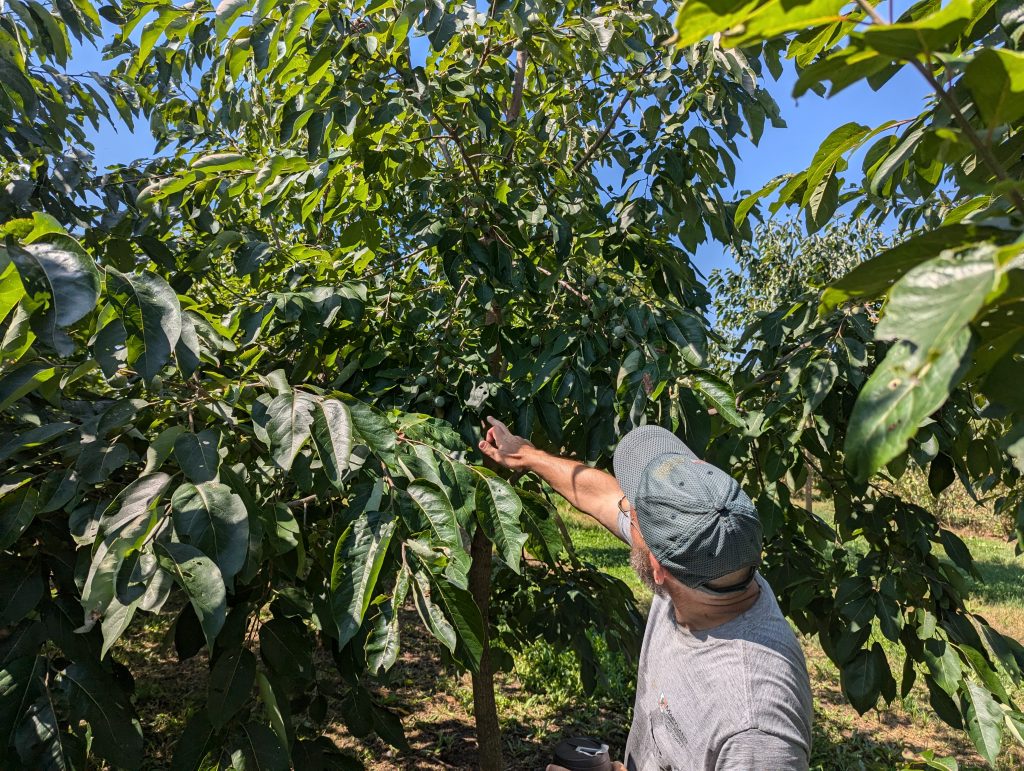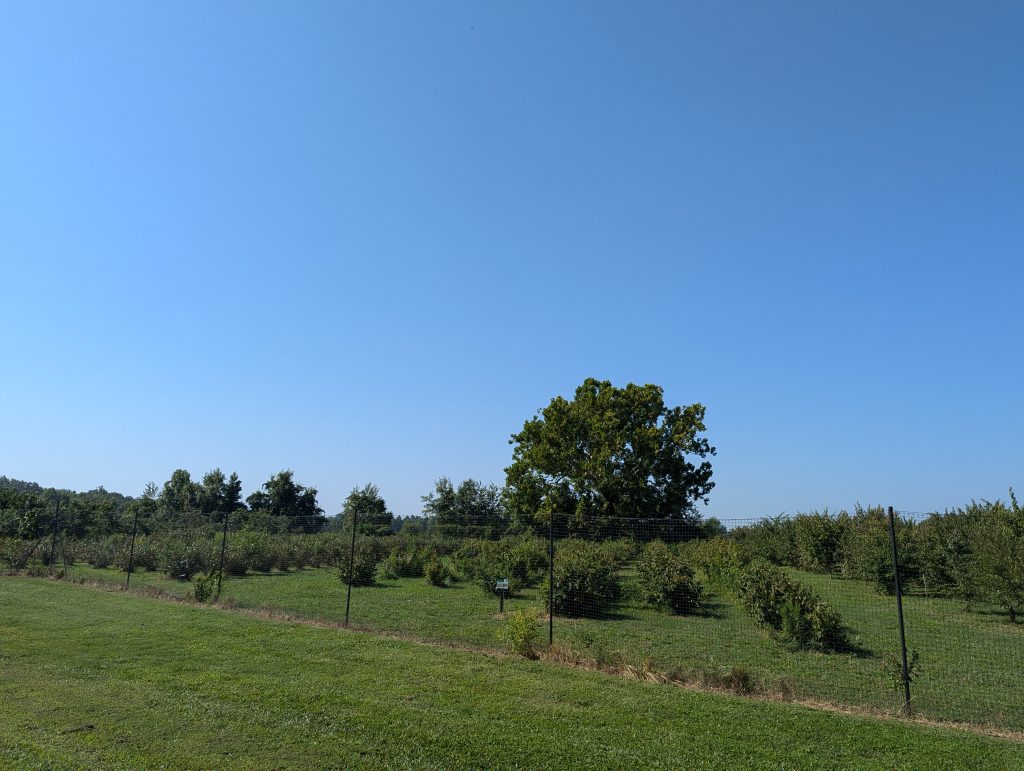Food forests bring harvests of fruit and deeper connections to the land
The Maryland Forest Service promotes the many benefits of creating a place for edible plants

Frances Smith, Maryland’s lead agroforestry planner, points out a persimmon on White Marsh Park’s Edible Trail. Photo by Joe Zimmerman, Maryland Department of Natural Resources.
Enter the neat ranks of White Marsh Park’s edible trail and pick some persimmons, blueberries or hazelnuts. If you follow their harvest schedule, you can pick them up at the branch and take them home with you, free of charge.
The Edible Trail is what might be called a food forest or forest garden. This is an example of agroforestry—a set of practices that include primarily native fruit and nut bearing trees and shrubs, as well as herbaceous species and fungi in the landscape. Taking ideas from both forestry and sustainable agriculture, agroforestry aims to create multifunctional areas that benefit people and the environment.
“It’s a different way of looking at the land and how to manage and farm it,” said Frances Smith, the state’s lead agroforestry planner and natural resource planner with the Maryland Forest Service, who served as the Edible Trail project designer.
It’s a new concept for public land in Maryland, but it’s also a return to older ideas about human relationships with the environment. Smith said he was inspired by local practices when he designed and installed much of the edible trail, which spans 1.5 acres in a corner of White Marsh Park in Centreville.
“It’s all based on indigenous, Native American knowledge,” he said. “These are things that the native people made and we’ve lost them. We are trying to bring back these species and these practices.
Planting and construction began on the eating trail in 2020, supported by a $10,000 outreach and restoration grant from the Chesapeake Bay Trust. Queen Anne’s County Parks and Recreation and the Corsica River Conservancy partnered with the Maryland Department of Natural Resources on the project.
Although the COVID-19 pandemic has disrupted some of the site’s maintenance, Smith said one of the benefits of food forests is that they require little maintenance once established. As woody perennials, they do not require annual replanting. Native plants were chosen that could thrive without fertilizer or an irrigation system, although Maryland Forest Service officials watered the plants during periods of drought. An 8-foot fence installed by forestry officials keeps the deer out, but remains unlocked for visitors.
Almost all species are fruiting this year, except for the pawpaw trees, which will take a few more years to mature. Visitors to the park can walk around the six plots picking blueberries, American plums, hazelnuts, chokeberries and persimmons. In the future, staff and volunteers may add beach plums, fruit berries or elderberries to the site.
The Edible Trail is now open for tours of what Smith described as a “playground and living laboratory” that shows what’s possible for food forests in the area and in one’s own backyard. Volunteers help weed and water plants, and an Eagle Scout built compost bins for the site.
Food forests and related agroforestry practices are beginning to gain traction in Maryland thanks to the efforts of the Maryland Forest Service, as well as the work of nonprofit organizations and residents.

American plums grow from a tree on the edible trail. Smith said many people don’t realize there is a native variety of plums, but they can be used for jams, juice, wine or can be dehydrated into prunes. Photo by Joe Zimmerman/DNR
Michael Judd, who runs a food forest called Long Creek Nursery at his home in Frederick County, said Maryland is particularly well-suited for food forests. A longtime permaculture advocate, Judd spent two decades building food forests in Nicaragua and said Maryland’s rainfall and growing season reminded him of Central America.
“When you look at the latent energy in the ground here, the energy in this area supports trees and tree crops,” Judd said. “The lawn you stop mowing will naturally regenerate as a forest. This energy is what this ecosystem is for – we are in a forest ecosystem, the ecosystem sustains [those trees] and they thrive.”
Judd and his family chose to settle in Maryland in part because of its potential for food forests, he said, calling it one of the “sweetest places on the planet to grow.” He runs the ecological landscape design firm Ecologia and co-founded the non-profit organization SilvoCulture, which plants walnut trees in the mid-Atlantic.
Lincoln Smith, the co-founder of Forested, LLC, a Bowie-based landscape design and education firm, said he has a list of 60 to 70 species that do well in Maryland’s food forests. These include many native plants, such as sochan (a type of black-eyed susan that makes nice foliage for eating or cooking) and ostrich ferns (which produce fiddlehead), as well as some cultivated species that are a good balance to the native habitat, such as Chinese chestnuts.
While some of these plants may be unfamiliar to many Marylanders, Smith said it’s also an opportunity for people to eat more diverse foods that are grown locally.
“A lot of the food we’re used to is not local,” he said. “At least half of the effort with forest horticulture is trying to introduce people to these foods and make them an enjoyable experience.”
That’s why Forested hosts a ‘forest feast’ every year, where a chef prepares produce from the food forest and showcases ways to cook chestnuts and persimmons.
Food forests often include polyculture—planting undergrowth and plant species that work together—to mimic cooperative systems found in nature. Although many plants are edible, some plants in a food forest may be selected for their benefits to other plants, pollinators, or birds.
Advocates note that food forests can take root anywhere, from the backyard to the edges of farmland. Silvopasture uses fruit-bearing and shade trees to provide food and shelter for animals.
“Let’s do less work and be more efficient at what we do instead of fighting nature all the time,” said Sabina Schaub, who recently introduced hazel bushes to her Upper Marlboro farm. She plans to harvest hazelnuts and let her sheep forage for the leaves, shoots and leftover nuts. “Let’s work with nature instead of fighting against it.”
Schaub’s planting was supported by a grant from the Maryland Department of Agriculture’s Healthy Soils Competitive Fund. Agroforestry grants and information resources are also available through The Nature Conservancy, Appalachian Sustainable Development, and Sustainable Agriculture Research and Education. Additional information and resources on agroforestry can be found at US Department of Agriculture National Agroforestry Center and University of Missouri Agroforestry Center.
Funds acquired through Chesapeake Bay Trust Plantation Grants may include portions of agroforestry such as food forests. Tree stands installed by restoration groups such as the Chesapeake Bay Resource Conservation and Development Alliance or Western Maryland will also include trees and shrubs that bear fruit or nuts, depending on the landowner’s goals.
Keith Olinger received a $52,500 grant in 2019 from the Department of Natural Resources through a Forest Conservation Act fund received from a Suburban Washington Sanitary Commission settlement that he uses for agroforestry practices on his farm in Howard County. including building hedges and growing avenues. He said he thinks rangeland and indigenous farming, which uses self-sustaining techniques inspired by nature, will be the “agriculture of the future”.

Rows of fruit and nut-bearing plants, most harvested from the John S. Ayton State Tree Nursery, on the White Marsh Park Edible Trail. Photo by Joe Zimmerman/DNR
Ben Fritton, director of the central Maryland nonprofit REED Center, points to food forests as a way to both create thriving ecosystems and meet acute human needs. Similar to the use of victory gardens in World War II, food forests can help people maintain sustainable places near where they live.
“We can’t just have land set aside for nature and have land for human use,” Fritton said. “We have to reintegrate these things.”
The Maryland Forest Service is integrating lessons from food forests into tree planting. In October, the Forest Service planted a demonstration native food forest behind the Brunswick Township Food Bank in Frederick County. When opportunity permits, the Forest Service also includes edible species in its regular plantings. Partnerships with the Maryland Department of Agriculture support the use of agroforestry and food forests for soil health benefits, where permanent rooting helps build organic matter and contributes to carbon sequestration.
Carbon absorbed by trees helps mitigate climate change. Trees also purify the air, filter and circulate water, and provide habitat for wildlife.
Planting something edible often gets people in the community excited about the work, said Anna Twigg, a tree planting specialist with the Forest Service, and it helps reiterate the many benefits of trees as Maryland works to 5 Million Trees Initiative.
“It’s a cool way to add another layer to tree plantings,” she said. “Besides all the other things trees do, it’s fun to be able to eat things from them.”
By Joe Zimmerman, science writer for the Maryland Department of Natural Resources

